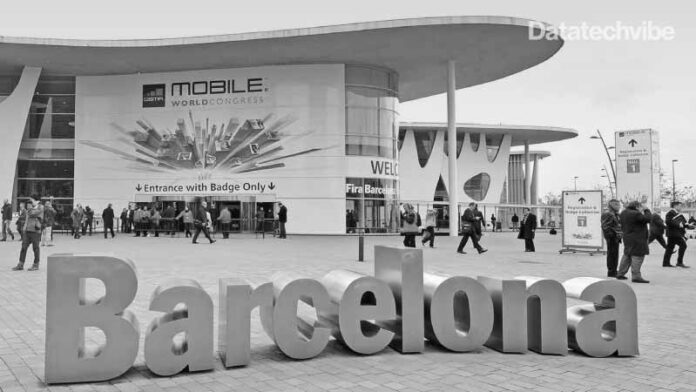There was plenty of technological innovation on display, spanning the metaverse and Wi-Fi 7 at the Mobile World Congress (MWC), which made a big comeback. Last week, thousands gathered at the event in Barcelona to hear the latest advancements in 5G and mobile technologies. Here are some highlights from the event that concluded last Friday.
Metaverse takes the centrestage
Facebook-parent Meta, which started the chatter about the metaverse last year — didn’t have much of a presence at the congress MWC. However, Mark Zuckerberg put out a statement saying its metaverse ambitions won’t be possible unless there are drastic improvements in telecoms infrastructure.
Telecom companies have begun taking baby steps into the metaverse. South Korean firm SK Telecom had a 4D Metaverse ride at its booth where attendees sat down on the ride and wore virtual reality headsets. They were then lifted up and carried around a digital representation of space.
At HTC’s stand, visitors could put on the Vive headsets and walk around a virtual museum. They could also walk around in a small pen while exploring a desert landscape in VR.
While attendees could get cooking lessons or swat giant 3D insects at the Qualcomm booth, they could climb the Notre-Dame Cathedral with Meta’s Oculus Quest 2 headset at the Orange booth.
Meanwhile, Spain’s Telefonica appointed Yaiza Rubio as its Chief Metaverse Officer, and semiconductor giant Qualcomm, said chips will need to get smaller, faster and less power-hungry if the metaverse is going to work.
Big tech announcements
Samsung, Oppo, OnePlus and Qualcomm made new announcements at the Mobile World Congress 2022. Oppo showed off its new Air Glass wearables, Nokia announced new C-series phones and Qualcomm announced the X70 modem, its successor to the X65 5G modem.
Meanwhile, Lenovo announced the new ThinkPad X13s, while Oppo introduced its 240W SuperVOOC flash charge technology and OnePlus and Realme announced that 150W charging is coming to some phones in the near future.
Honor launched new-generation earbuds that have an original feature. The Earbuds 3 Pro are capable of taking the wearer’s body temperature. We see Apple incorporating
similar technology in its upcoming AirPods Pro.
Meanwhile, Xiaomi turned heads with its CyberDog, largely inspired by the famous Spot robot from Boston Dynamics. Although, at the moment, the robot-dog can only walk and sit, its future applications could be locating survivors in hazardous terrains after natural disasters.
There was also talk of Wi-Fi 7 at MWC, with Qualcomm presenting the FastConnect 7800.
On paper, it promises a theoretical maximum throughput of 5.8 Gb/s and very low latency.
Wi-Fi 7 should offer speeds two to three times faster than Wi-Fi 6 and will reduce latency by transmitting the signal over more bands, thus avoiding interference.
This wireless connection will aid the growing needs of online video games, virtual or augmented reality applications. The first Wi-Fi 7-compatible products are expected to hit the market in 2023.
In other tech news, Cisco announced plans for its Cisco Private 5G together with partners. Officials said it will support productivity for enterprises with IoT adoption. Cisco is supporting the combination of Wi-Fi, 5G and IoT to power enterprises in efforts to connect physical operations with information systems and leverage analytics, artificial intelligence, automation and machine learning.
Other tech innovations at MWC focused on 3D models motion tracking, environment tracking, body tracking and face tracking. HMS Core featured innovations in graphics and video, 3D product display, and gaming.
5G connections to hit 2 billion in 2025
The GSMA reported 5G connections will surpass 1 billion in 2022 and 2 billion by 2025. By the end of 2025, 5G will represent one in five of total mobile connections. Who will have access to 5G networks by then? About 40 per cent of people will live in an area with access to 5G.
“5G accounts for a much larger share of global mobile connections than 3G or 4G did at the same point in their life cycles. Momentum has been boosted by factors including innovative plans, video streaming services, rising 5G handset sales, and network coverage expansions,” said Alex Sinclair, chief technology officer, GSMA.
Earlier, Ericsson Mobility Report found that 5G is estimated to reach 80 million subscriptions in MENA by 2025.
From allowing for access to advanced AR experiences and facilitating the metaverse, to allowing everything to run at faster speeds, 5G is changing the game. It’s no surprise that more than 90 per cent of marketing professionals worldwide expect 5G to have an impact on their industry. Marketers will make the most of 5G technology to improve the digital experience, including mobile commerce and social commerce, mobile wallets and contactless payments for onsite and offsite shopping, geotargeting and geofencing and interactive marketing – from AR experiences to apps – and in-game engagement.
Sinclair said the 5G momentum is boosted by factors including innovative plans, video streaming services, rising 5G handset sales and network coverage expansions.
Digital empowers humanitarianism
Technology builds customer experiences, and extends to goodwill on a global stage.
At the World Mobile Congress, the UK committed about $20.7 million more to the GSMA Mobile for Humanitarian (M4H) Innovation Programme. That doubles the total amount the European country has given to the M4H program since 2017. The move enables the GSMA’s vital work to deliver mobile and digital humanitarian assistance to those most in need.
Using new and proven technologies will help the GSMA M4H programme to reach over 17 million people facing global humanitarian crises such as displacement and hunger by 2025. GSMA M4H program offers assistance with life-enhancing and lifesaving mobile-enabled services.









